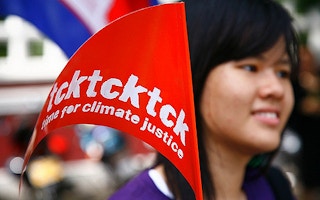One of the world’s most famous climate scientists has just calculated the financial burden that tomorrow’s young citizens will face to keep the globe at a habitable temperature and contain global warming and climate change – a $535 trillion bill.
And much of that will go on expensive technologies engineered to suck 1,000 billion metric tonnes of the greenhouse gas carbon dioxide from the air by the year 2100.
Of course, if humans started to reduce greenhouse gas emissions by 6 per cent a year right now, the end of the century challenge would be to take 150 billion tonnes from the atmosphere, and most of this could be achieved simply by better forest and agricultural management, according to a new study in the journal Earth System Dynamics.
The study, authored by researchers from the US, France, China, the United Kingdom and Australia, rests on two arguments.
“
Continued high fossil fuel emissions would saddle young people with a massive, expensive cleanup problem and growing deleterious climate impacts, which should provide incentive and obligation for governments to alter energy policies without further.
James Hansen, Columbia University Earth Institute
Slow start
One is that although the world’s nations vowed in Paris in 2015 to contain global warming by 2100 to “well below” 2°C relative to the average global temperatures for most of the planet’s history since the last Ice Age, concerted international action has been slow to start. One nation – the US – has already announced that it will withdraw from the Paris Agreement.
The other argument is that, even if humans do in the decades to come rise to the challenge, it could be too late: by then greenhouse gas concentrations could have reached a level in the atmosphere that would in the long run condemn the world to sea level rises of several metres, and a succession of economic and humanitarian disasters.
“Continued high fossil fuel emissions would saddle young people with a massive, expensive cleanup problem and growing deleterious climate impacts, which should provide incentive and obligation for governments to alter energy policies without further delay,” says James Hansen, of the Columbia University Earth Institute in the US, who led the study.
Professor Hansen, as director of the US space agency Nasa’s Institute for Space Studies, made global headlines in 1988, during a severe drought and heatwave on the North American continent, when he told a Washington senate committee: “It’s time to stop waffling so much and say the evidence is pretty strong that the greenhouse effect is here.”
Legal testimony
With that one sentence, he made climate science an enduring item on the political agenda. But the latest study is also part of a legal argument. It is in effect testimony in a lawsuit called Juliana et al vs the United States.
This case began under the last US administration. However, the US president, Donald Trump, who has dismissed the evidence of climate change as a “hoax”, has now been named in the case.
Professor Hansen has argued that even the ambitions of the historic Paris Accord will not be enough to avert disaster and displacement for millions. The benchmark for geologically recent warming levels was set 115,000 years ago, during a period between two Ice Ages, known to geologists as the Eemian.
“We show that a target of limiting global warming to no more than +2°C relative to pre-industrial levels is not sufficient, as +2°C would be warmer than the Eemian period, when sea level reached plus 6-9 metres relative to today,” Professor Hansen said.
Lower CO2
At the heart of such arguments are calculations about imponderables that climatologists like to call the carbon budget and climate sensitivity. The first of these concerns the terrestrial and oceanic processes that release greenhouse gases into the atmosphere and then absorb them, and the second is a calculation about what a change in carbon dioxide levels really means for average global temperatures.
For most of human history, CO2 levels were around 280 parts per million. In the last two years they have reached 400 ppm, as a response to two centuries of fossil fuel combustion, and average global temperatures have risen by almost 1°C, with a record reading in 2016 of 1.3°C.
Professor Hansen and his colleagues want to see these atmospheric CO2 levels lowered to 350 ppm, to bring global temperature rise down to no more than a rise of 1°C later this century.
If the world’s nations can co-operate to do that, then most of the hard work to remove the carbon dioxide surplus from the air could be left to the world’s great forests.
However, if carbon emissions go on growing at 2 per cent a year (and during this century, they have grown faster), then those who are children now would have to commit to a costly technological answer based on the belief that carbon dioxide can be captured, compressed and stored deep underground.
Nobody knows how to do this on any significant scale. And if it could be done, it would be expensive: an estimated €500 trillion, or US$535 trillion.
“It is apparent that governments are leaving this problem on the shoulders of young people. This will not be easy or inexpensive,” says Hansen.
“We wanted to quantify the burden that is being left for young people, to support not only the legal case against the US government, but also many other cases that can be brought against other governments.”
This story was published with permission from Climate News Network.

















